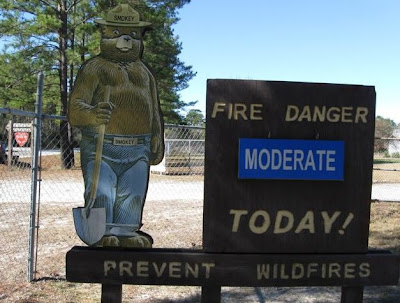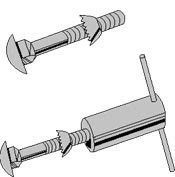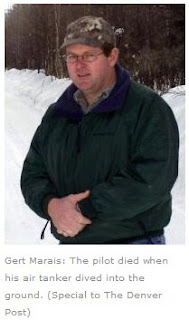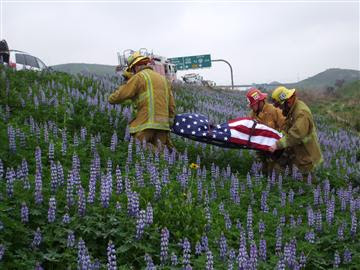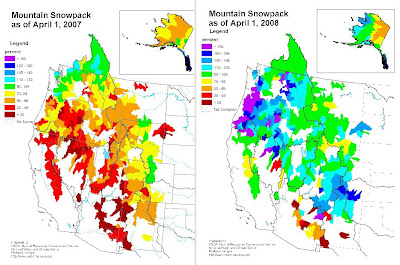We have been busy with end-of-the-year wrap-ups.
On Monday we posted
a list of fatalities on wildland fires. After combing through the 800+ posts on Wildfire Today during 2008, on Tuesday, December 30, we listed the
top stories for January-April. Today we'll cover May-August, and on January 1,
September-December.
Posted below are excerpts from the articles. To read the entire articles, click on the links.
May 10California: Schwarzenegger's fire preparedness
The California governor seems to be concerned about the wildfire potential this summer. In a press conference he was talking about the fire hazards around his home:
"I was not aware of it until an expert from the fire department told me that, 'This is terrible. This is a fire hazard all around your house -- you are living in the middle of it, get rid of this grass, get rid of these shrubs or you are going to be in trouble.'
He issued a lengthy
Executive Order that detailed numerous policies that will affect CalFire this year. Here are some of the highlights:Staff additional fire crews, fire engines, helitack crews, fire bulldozers, equipment and aviation resources as warranted based on fire threat conditions.
May 12"Wildland Firefighter" demobilizes
Wildland Firefighter magazine just announced in it's May issue that it is ceasing publication. It will no longer exist as a stand-alone publication dedicated to wildland fire. In a publisher's note, Jeff Berend, the Vice President and Publisher said:
"Beginning in June, we will be merging Wildland Firefighter into a new Wildland/Urban Interface (WUI) section in FireRescue magazine.....
But from a business perspective, we simply have not been able to grow the readership or advertising beyond that loyal core. At the same time, publishing costs have risen at unprecedented levels."
Wildland Firefighter and
FireRescue are both published by
Elsevier Public Safety.
Wildland Firefighter became the "official publication of the International Association of Fire Chiefs" a couple of years ago after the IAFC severed their relationship with
Fire Chief magazine.
This leaves
Wildfire magazine, an "official publication of the
International Association of Wildland Fire" as the only remaining magazine-type publication dedicated solely to wildland fire.
May 28Increased risk of bladder cancer for firefighters
It seems like there are more and more
chronic diseases that firefighters are predisposed to get. Now you can add bladder cancer to the list.
ScienceDaily (May 15, 2008) — A new study presented at the Annual Scientific Meeting of the American Urological Association (AUA) suggests that firefighters may be at an increased risk of developing transitional cell carcinoma (TCC, or bladder cancer) and should be considered for routine annual screening. Currently, no guidelines exist for regular TCC screening.
May 29Montana: two firefighters struck by lightning
Two firefighters working on a prescribed fire on the Flathead National Forest were struck by lightning Thursday. They were on on the Tally Lake Ranger District when lighting struck some trees near where they were working. The firefighters, a 25-year old woman and a 29-year old man are members of a Hot Shot crew. Both were both transported to hospitals, the woman by helicopter and the man by ambulance. They are listed in stable condition.
May 30San Diego Grand jury issues scathing report about fire preparedness
The Grand Jury of San Diego County investigated the response to the Witch Creek and Guejito fires of last fall that burned 368,340 acres, destroyed 2,653 structures, and claimed the lives of 10 citizens . They just issued
their report and it pulls no punches.
June 2Terry Barton released from prison

Terry Barton, convicted of starting the 138,000 acre Hayman fire in 2003, was released from prison this morning. She started the fire while she worked as a Fire Prevention Technician on the Pike National Forest in Colorado.
The fire burned 133 homes and forced 8,000 people to evacuate, including the judge who presided over one of the proceedings related to the case. She served six years in a federal prison in Fort Worth, Texas.
Wildfire Today covered other aspects of this story
HERE.
The picture is from 2002 when she appeared in court, courtesy of the Denver Post.June 3Fire season outlook for Washington
The Wenatchee World web site has an interesting story about the outlook for fire activity in north central Washington state this year.
Officials say other than a late start to the season, there are no strong indicators for predicting this year's season.
"We're always going to have a fire season. And it's always going to depend on how receptive (fuels) are to ignition, and then, do we get ignition," said Bobbie Scopa, fire management officer for the Okanogan-Wenatchee National Forests.
Scopa said the season will partly depend on June rains, although lots of rain can mean high grasses, which dry out quickly in hot weather and allow for a fast-spreading fire. Mostly, she said, it will depend on the number of fires started by lightning storms, escaped campfires or vehicles and equipment without spark arresters.
Scopa said snowpack may help determine when the fire season will start but isn't always an indicator of the severity of the season. She pointed to 2005, one of the driest winters on record, when North Central Washington saw little fire activity. That was followed by 2006, when a winter with heavy snowpack melted into a summer with the 175,000-acre Tripod Fire — the largest wildfire in the region's history.
"It's pretty tough to make too big a prediction," she said.
However, Rick Ochoa, a meteorologist working at NICC in Boise, said:
"...the cooler spring weather and heavy snowpack do mean that overall there's a slimmer chance that the Northwest will have numerous large fires."
Ochoa further goes out on a limb to predict:
"...the Northwest will see 473 fires, burning 17,873 acres by the end of June. That's compared with an average for June 30 of 605 fires burning 24,508 acres."
UPDATE, December 29, 2008
For the 12-year period, 1985-2006, in the Northwest Geographic Area, there were an average of 6,774 fires per year for a total average acreage of 627,884. The average size of the fires was 93 acres.
In 2008, through October 7, there were 3,927 fires for a total acreage of 289,853. The average size of the fires was 73 acres.
June 4Fire in North Carolina makes 5-mile run

The Evans Road fire in North Carolina last night jumped containment lines and "made a 5-mile run" according to the NC Division of Forest Resources. The fire which tripled in size yesterday has now burned 10,000 acres in Hyde and Washington counties, and has spread onto the Pocosin Lakes National Wildlife Refuge.
UPDATE, December 29, 2008
The fire eventually burned over 40,000 acres. The last update on
Inciweb on August 5 showed that it was 90% contained at 40,704 acres.
June 11Ophir Fire2 miles south of Oroville, California, 1,600 acres, 21 residences and 28 outbuildings lost. The spread of this fire has been stopped for now.
The photo of the Ophir fire below is courtesy of the Enterprise-Record. June 12California: Staffing shortages in USFS
June 12California: Staffing shortages in USFS
An excerpt from a lengthy article in the
Press-Enterprise:
By BEN GOAD
Washington Bureau Roughly a third of California's fleet of federal fire engines is currently unavailable due to staffing shortages, according to figures supplied by a group that represents U.S. Forest Service crews.
Statewide, only 186 of the agency's 276 engines were ready to respond to fires as of Friday, according to a report created by fire officials and released by the Federal Wildland Fire Service Association.
June 14California: Indians and Humbolt fires
On Wednesday a U.S. Forest Service engine from the Los Padres NF was burned over while they were attacking a spot fire on the Indians fire. From a news release by the USFS:
Narrative: At approximately 1615 hours while supporting a firing operation, Engine-71 was involved in a localized fire blow-up. A cyclonic fire wind event caused four members of Engine-71 to be overcome by the fire. The crew was suppressing spot fires near the roads edge when they experienced extreme fire and wind behavior.
Winds were estimated to be 60 – 70 mph. Limbs from large oak trees were blown out of trees and small, golf ball size rocks, were thrown into the air. The radiant heat caused the burns to the fire fighters. Initially, the firefighters were treated at the ICP medical unit, two were sent to a local hospital for further treatment and the most serious burn victim was flown to Valley Burn Center in Santa Clara. A fourth firefighter did not initially seek treatment. After further consideration, the 4th firefighter chose to see a physician. The three firefighters have been referred to the Fresno Burn Center for further examination.
June 16Engine burnover near Lincoln, California
Another engine burnover--this time it was two Placer County Fire Department brush engines on the Nicolaus fire near Lincoln, CA on June 11. Here is an excerpt from CalFire's "24-hour report" recently released:
....Approximately seven minutes into the fire, E70 (IC) reported that units were being burned over. Appropriate EMS was requested.
The volunteer firefighter from BR 75 sought refuge on the leeward side of the apparatus. The fire intensity continued to increase and he retreated to safety, crossing a barbed wire fence, into a stubble field immediately to the east of the dirt road. He was met by apparatus and personnel from Lincoln Fire Department and escorted to ambulance personnel.
The CAL FIRE Firefighters from BR 73 tried to seek refuge in the cab, but were quickly overrun. They retreated through the flame front to the west, into the burn. Both of the firefighters walked north through the burn and exited where E70 was parked on Nicolaus Road.
All firefighters were treated and transported to UC Davis Medical Center. The volunteer firefighter from BR 75 received burns to the nose, was treated and released. The firefighters from BR 73 remain in the Burn Unit in stable condition with burns to the face and hands. They are expected to remain at UC Davis Medical Center for 7 to 10 days.
June 19Firefighters' dirty drinking water, and "shift food"
The Missoula Technology and Development Center (MTDC) just published the 12th edition of the
"Wildland Firefighter Health and Safety Report" written by Brian Sharkey (if you don't have the user name and password, go
HERE):
Water bottles are filthyResearchers found loads of nasty stuff in the water bottles and drinking systems of firefighters. They tested the bottles or systems of 15 firefighters and found that several of them had high concentrations of molds and yeasts.
Legionella-like bacteria, which causes Legionnaires' disease, were detected in one water bottle and in one drinking tube.
June 21National Geographic article about wildland fire
On May 16 Wildfire Today
gave you a heads up about an article on wildland fire that would appear in the July issue of National Geographic. It should be arriving in mailboxes right now, but their web site has on online version of the article and some amazing pictures of fires. No one takes pictures like the NG photographers, and they did not disappoint this time. Here is an example (click on it to see a larger version):

Photographer Mark Thiessen took most, if not all, of the photos--some of which can be found
HERE. The online version of
the article is here. It's lengthy, on ten web pages.
Be sure to read
the interview with Thiessen about how he got the photos. One thing that helped....he has a red card and has shot photos of fires for 10 years.
June 21More about Northern California lightning bust
From the reports I have seen, there are at least 300-400 fires that were started by the lightning that moved across the northern part of California from west to east during the last 24 hours. As this is written, lightning is still occurring in northeastern California.
Most of the fires are very small, their growth muted for a while by the overcast skies that brought the thunderstorms. But as the skies clear, smoke from a few large ones northwest of Redding and west of Ukiah is becoming visible in satellite photos. Only a small percentage of the fires are staffed and many new ones are being discovered every hour.
This situation is going to become dire unless the northern half of the state receives a great deal of rain in the next day or two. The weather forecast for the next several days at Redding shows temps in the low to mid 90's, moderate winds, minimum RH's in the high teens, and very little chance of rain.
It is starting to look like it could become another summer like the
"Siege of 1987" when lightning in late August started 1,600 fires in northern California and southern Oregon that burned 650,000 acres. Some of the fires burned into October.
UPDATE, December 29, 2008
The 25,000 lightning strikes in northern California on June 20-21 started over 1,700 fires and as of July 4 had burned 520,831 acres.
The smoke generated by the fires in California had a profound effect on residents in the northern part of the state for weeks. It also affected other portions of the country. Here is an example of a map showing smoke dispersal on July 3. The red dots are heat sources detected by satellites.
 June 23Fire near Big Sur closed coast highway
June 23Fire near Big Sur closed coast highway
The
Gallery fire, now part of the
Basin Complex burning south of Big Sur in California, is now reported to be 2,000 acres. Judging from the satellite map below it is at least that big. The coast highway, Highway 1, had been closed by the fire. Now it is closed by a landslide.
The
Indians fire, also shown on the map, is 56,044 acres. Yesterday firefighters did some burning out and according to a spokesperson "We had a really good day today". The heat shown on the map may be their burnout operations. It looks like there is a chance that Bill Molumby and his team may even catch this fire and it won't be another Los Padres wilderness fire that burns all summer.

UPDATE, December 29
The Indians fire eventually burned 76,554 acres after a large burnout operation along the Arroyo Seco river on the north side stopped the spread. The Basin Complex, which consumed 162,818 acres, burned into the Indians fire.
June 23Clover fire, while still a WFU

I came across a map, above, of the Clover fire on the Sequoia National Forest, while it was still a Wildland Fire Use (WFU) fire on June 18. On the north and west sides, it was mostly hemmed in by previous fires that burned 2-4 years previously. On the east and southeast sides was an old 64-year old burn, and there was no fire history on the southwest side. The black line east of the fire is the Kern River.
Yesterday the fire crossed the Kern River, crested the Sierras, and burned east toward Hwy. 395
June 29U.S. Forest Service's "Key Messages"
The U. S. Forest Service in California is aggressively trying to get certain messages out about the fire situation in northern California by issuing a laundry list containing 10 "
Key Messages". They took the extraordinary step of having them inserted into the Northern California Geographic Area Coordination Center's
"News and Notes", which usually contains just the bare facts and numbers about initial attacks and ongoing fires.
This may be in response to allegations by some that the USFS is losing many key firefighters to agencies that have much better pay and benefits packages, leaving the agency in California with too many unfilled positions and unstaffed engines.
Martin Mars lands at Lake Shasta
The third time proved to be the charm for the Canada-based Martin Mars air tanker. After having engine problems on Friday and Saturday, it successfully completed it's 4-hour trip to Lake Shasta north of Redding, California this morning. It will stage there until it receives an assignment, which will likely occur today, visibility permitting. On each mission it can drop 7,200 gallons of water, Thermogel, or water mixed with foam concentrate on a fire and then will refill it's tank by scooping water from a lake.
Wildfire Today covered the saga of this aircraft earlier,
here and
here.
 The Martin Mars anchored on Lake Shasta, June 29. It has already been outfitted with an American flag and a USFS decal. Click on the photo to see a larger version. Photo courtesy of ShastaLake.com.July 1N.C.-- Eight firefighters struck by lightning
The Martin Mars anchored on Lake Shasta, June 29. It has already been outfitted with an American flag and a USFS decal. Click on the photo to see a larger version. Photo courtesy of ShastaLake.com.July 1N.C.-- Eight firefighters struck by lightning
From
WCNC.com--

LENOIR, N.C. -- Five firefighters are still in a hospital after being struck by lighting while battling a forest fire.
A total of eight firefighters with the North Carolina Forest Service were trying to contain the blaze Saturday, which was sparked by lighting the day before. The strike happened at 4:48 p.m.
Forestry officials believe the lightning bolt hit a tree; the energy radiated underground, where the firefighters were taking a break. They say the sky was clear blue at the time.
Initially, all eight firefighters were hospitalized. Doctors are treating the remaining five firefighters at Caldwell Memorial Hospital. Four of the eight are inmates who assist the forest service though a work release program.
(More information was posted later HERE.)
July 3
California: Two dozer rollovers
Two dozer operators rolled their dozers on Tuesday. One was wearing a seat belt and one was not.
A private contractor assigned to the Cold fire in Plumas County suffered a fractured skull, a dislocated shoulder and injuries to one ear when the bulldozer he was operating rolled over, said Dave Olson, a fire information officer for the Canyon Complex of fires on Plumas National Forest.
The employee of Oilar Agricultural Services, based in MacArthur, was flown to Enloe Medical Facility in Chico, where he was in stable condition Wednesday with no life-threatening injuries, Olson said.
In Siskiyou County, a contract operator was digging a fire line between the Alps Complex fire and the Ironside fire when his bulldozer rolled 80 feet down an embankment, said Alexis West, a fire information officer on the complex of fires burning on Shasta-Trinity National Forest.
The operator was wearing a seat belt, which probably saved his life, West said. He was taken to a Redding hospital, where he was treated for arm and shoulder injuries.
He was conscious and alert in Mercy Medical Center on Wednesday morning, West said.
July 5Martin Mars reloads

I wonder what kind of wake the Martin Mars creates when it skims along a 3-mile stretch of Lake Shasta filling its 7,200 gallon tank at 80 miles per hour? It probably makes the lake a little choppy for the water skiers for a few minutes.
July 1044 Australia and New Zealand firefighters coming to help the U.S.
On Saturday, U.S. time, 44 Australian and New Zealand firefighters will depart for the United States to assist with the wildland fires in California. The contingent will travel to the National Interagency Fire Center in Boise, Idaho for a briefing and to be issued equipment.
July 11Basin fire burns around Tassajara
The Basin fire, east of Big Sur, made huge runs yesterday, burning completely around the Zen Center at Tassajara. It is now 108,026 acres and is 41% contained, adding about 18,000 acres over the last 24 hours.
July 17Four men trapped, three burned on Motion fire
Four men wearing camouflage clothing were found in the Motion fire on the Whiskeytown National Recreation Area in northern California after one of them made a call in Spanish to 911. The area was burning vigorously and several strike teams of engines, hand crews, and dozers were staged along roads preparing for a burning operation.
Of the four Hispanic males, three of them had burn injuries. Jose Alcazar Fernandez, 25, was flown to Mercy Medical Center with third degree burns and was later transferred to the UC Davis burn unit. A second adult and a juvenile were transferred by ground ambulance, then treated for first and second degree burns and smoke inhalation and released. The juvenile male was treated and released for minor burns. The treated adult and a fourth adult male were arrested on federal charges of being present in a closed area.
Law enforcement officers determined that the men were Mexican nationals unlawfully present in the United States. They claimed to have been hunting in the park but refused to say where their weapons were. A marijuana cultivation site had been under investigation nearby and fire overhead and suppression personnel had repeatedly been briefed over the previous few days as to the specific location of the site and the probability of armed suspects in the area.
Firefighter rescues bear cub in fire, then begins treatment for rabies
Yesterday Wildfire Today brought you
the story of the horse that was
rescued by a crew on the Mill fire on the Mendocino National Forest. Now it's a bear.... a story not unlike the original Smokey Bear.
A Cal Fire Field Observer on the Moon fire in northern California, Adam Deem, found a be

ar cub while he was scouting the fire. The bear had some burns on his paws and was having difficulty walking. Deem looked for the cub's mother but could not find her, so he caught the bear and wrapped him in his brush jacket. In grabbing the cub, Deem received some scratches on his hands which required that he receive treatment for rabies.
Deem cradled the bear in his arms as he drove his pickup to a staging area. From there he and the cub were driven to the Incident Command Post in Anderson. Deem said on the way to the ICP he comforted, petted and sweet-talked the little cub.
At the ICP the Medical Unit treated the bear for dehydration and let him lick a lollipop before a state Fish & Game wildlife biologist picked it up for the trip to the Sacramento area rescue shelter.
UPDATE December 29, 2008
The bear, dubbed Li'l Smokey, is recovering well at the Lake Tahoe Wildlife Care center. He has
his own blog and sometimes a live web cam that works occasionally. The Center expects to release him into the wild this winter.
July 26Gunbarrel fire; largest Fire Use fire ever?The Gunbarrel fire, east of Yellowstone National Park and west of Cody, Wyoming, started on July 26. For many weeks it was managed as a fire use fire, becoming one of the largest fire use fires ever. On August 24 it was converted to a suppression fire after it had burned 53,000 acres. The last reported size on
Inciweb was 67,141 acres.
July 29New Smokey Bear ad cancelled
On June 3
Wildfire Today told you about
the new Smokey Bear public service announcements. An off road vehicle group complained that one of the ads seemed to imply that the legal use of an ATV could cause forest fires. Don Amador, the Western representative of the BlueRibbon Coalition in Idaho, said the ad:
"...incorrectly conveyed to the ATV rider that the best way for them to prevent wildfires was to stay at home. Instead, the ad should have encouraged the use of Forest Service-approved spark arresters and limiting travel to approved routes and areas."
The Forest Service has requested that TV stations discontinue using the ad.
July 31 Cascade fire update, Red Lodge, MT
The Cascade fire, pushed by strong winds, grew substantially towards the east in the last 24 hours, from 5,936 to 9,411 acres. Late on Wednesday it was about a mile from the Red Lodge Mountain ski area and three miles west of Red Lodge, Montana. The
Billings Gazette has an interesting article about the fire.
There is
another article about Tom Moore, who lost a cabin in the Cascade fire and two years ago lost his house in a fire in Idaho.
The map was created at 5:00 p.m. on Wednesday.

HERE is the Inciweb page about the fire.
August 5
Firefighter "roughed up" by grizzly bearThe firefighter that was
roughed up by the grizzly bear while working on the
LeHardy fire in Yellowstone National Park is back at work.
Tony Allabastro, a member of the Lewis and Clark Forest Service hotshot crew based in Great Falls, reportedly saw the bear over his shoulder, coming from where his crew had been doing controlled burns, Sandy Hare, public information officer for the LeHardy fire, said Monday.
Before he had a chance to get his bear spray, the grizzly pounced on him and “roughed him up,” Hare said. The bear was “acting instinctually.”
“(The bear) just wanted out,” Hare said. “There was something in its way, and it happened to be a human.”
Allabastro got away with minimal injuries. He was treated at the Yellowstone Clinic in Lake, Wyo., for scratches and bruises Sunday and released.
[...]
Allabastro, who has fought wildfire for three seasons and served on a hotshot crew for one, was tackled by the grizzly while working on a burnout near Fishing Bridge.
To be continued-The final installment, stories from September through December, will be in an article on
January 1.

